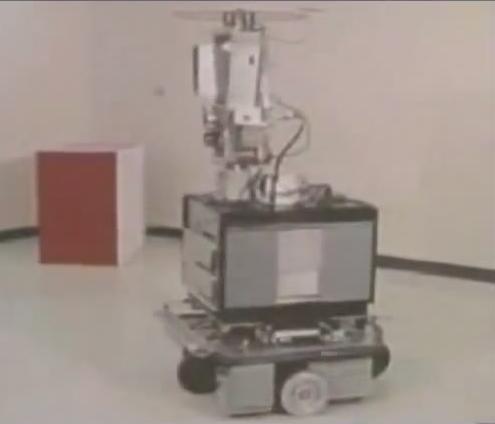Shakey the robot was the first general-purpose mobile robot to be able to reason about its own actions. While other robots would have to be instructed on each individual step of completing a larger task, Shakey could analyze the command and break it down into basic chunks by itself.[1][2][3][4]
Shakey was developed from 1966 through 1972 at the Artificial Intelligence Center of Stanford Research Institute (now called SRI International) with Charles Rosen as project manager. Other major contributors included Nils Nilsson, Alfred Brain, Bertram Raphael, Richard Duda, Peter Hart, Richard Fikes, Richard Waldinger, Thomas Garvey, Jay Tenenbaum, and Michael Wilber. The project was funded by the Defense Advanced Research Projects Agency (DARPA).[2]
The Shakey project combined research in robotics, computer vision, and natural language processing. It was the first project that melded logical reasoning and physical action.[2]
Originally, Shakey was controlled by a SDS-940 computer acquired in 1966 with 64K 24-bit words of memory. Programmed in Fortran and Lisp, Shakey’s problem solving was done in QA3 (Question Answering system, version 3). This was replaced by a “large” PDP-10 around 1969 with 192K 36-bit words of memory. Also in 1969, the demonstrations of Shakey were collected in a 24-minute film “SHAKEY: Experimentation in Robot Learning and Planning”. When the movie was made, Shakey’s programs occupied over “300,000 36-bit words” (~1.35MB). STRIPS (Stanford Research Institute Problem Solver) was then used for problem solving, with QA4 developed later.[1][3]
Testing of Shakey. [6]
Some of the most notable results of the Shakey project include the A* search algorithm, the Hough transform, and the visibility graph method. Shakey was inducted into Carnegie Mellon University’s Robot Hall of Fame in 2004. Now retired from active duty, Shakey is currently on view at the Computer History Museum in Mountain View, California. The Shakey project inspired numerous other robotics projects.[2]
References:
1. AI Center :: Shakey. – Mode of access: http://www.ai.sri.com/shakey/.
2. Shakey the robot. – Mode of access: http://en.wikipedia.org/wiki/Shakey_the_robot.
3. Робот Шекі. – Mode of access: http://uk.wikipedia.org/wiki/%D0%A0%D0%BE%D0%B1%D0%BE%D1%82_%D0%A8%D0%B5%D0%BA%D1%96.
4. Shakey. – Mode of access: http://ru.wikipedia.org/wiki/Shakey.
5. SHAKEY: Experimentation in Robot Learning and Planning. – Mode of access: http://www.ai.sri.com/movies/Shakey.ram.
6. Shakey. – Mode of access: http://www.youtube.com/watch?v=qXdn6ynwpiI.
7. SRI International. – Mode of access: http://en.wikipedia.org/wiki/SRI_International.
8. SRI International | An Independent Nonprofit Research Institute. – Mode of access: http://www.sri.com/.
9. Robot Hall of Fame. – Mode of access: http://en.wikipedia.org/wiki/Robot_Hall_of_Fame.
10. Зал славы роботов. – Mode of access: http://ru.wikipedia.org/wiki/%D0%97%D0%B0%D0%BB_%D1%81%D0%BB%D0%B0%D0%B2%D1%8B_%D1%80%D0%BE%D0%B1%D0%BE%D1%82%D0%BE%D0%B2.
11. Computer History Museum. – Mode of access: http://www.computerhistory.org/.
12. STRIPS. – Mode of access: http://en.wikipedia.org/wiki/STRIPS.
13. STRIPS. – Mode of access: http://uk.wikipedia.org/wiki/STRIPS.
14. STRIPS. – Mode of access: http://ru.wikipedia.org/wiki/STRIPS.
15. Интеллектуальное планирование / QA3 (Question Answering system, version 3): обзор. – Mode of access: http://ai-center.botik.ru/planning/index.php?ptl=materials/qa3-overview.htm.
16. A* search algorithm. – Mode of access: http://en.wikipedia.org/wiki/A*_search_algorithm.
17. Алгоритм пошуку A*. – Mode of access: http://uk.wikipedia.org/wiki/%D0%90%D0%BB%D0%B3%D0%BE%D1%80%D0%B8%D1%82%D0%BC_%D0%BF%D0%BE%D1%88%D1%83%D0%BA%D1%83_A*.
18. Алгоритм поиска A*. – Mode of access: http://ru.wikipedia.org/wiki/%D0%90%D0%BB%D0%B3%D0%BE%D1%80%D0%B8%D1%82%D0%BC_%D0%BF%D0%BE%D0%B8%D1%81%D0%BA%D0%B0_A*.
19. Hough transform. – Mode of access: http://en.wikipedia.org/wiki/Hough_transform.
20. Преобразование Хафа. – Mode of access: http://ru.wikipedia.org/wiki/%D0%9F%D1%80%D0%B5%D0%BE%D0%B1%D1%80%D0%B0%D0%B7%D0%BE%D0%B2%D0%B0%D0%BD%D0%B8%D0%B5_%D0%A5%D0%B0%D1%84%D0%B0.
21. Visibility graph. – Mode of access: http://en.wikipedia.org/wiki/Visibility_graph.
22. Galindo C. Multiple Abstraction Hierarchies for Mobile Robot Operation in Large Environments / Cipriano Galindo, Juan-Antonio Fernandez-Madrigal, Javier Gonzalez. – Berlin : Springer, 2007. – 180 p.
23. Siegwart R. Introduction to Autonomous Mobile Robots / Roland Siegwart, Illah R. Nourbakhsh. – Cambridge ; London : The MIT Press, 2004. – 322 p.
24. Autonomous Mobile Robots : Sensing, Control, Decision Making and Applications / ed. Shuzhi Sam Ge, Frank L. Lewis. – Boca Raton ; London ; New York : CRC Press, 2006. – 698 p.
